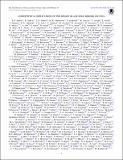ASTROPHYSICAL IMPLICATIONS OF THE BINARY BLACK HOLE MERGER GW150914
Author(s)
LIGO Scientific Collaboration; Virgo Collaboration; Arggarwal, Nancy; Barsotti, Lisa; Biscans, Sebastien; Brown, N. M.; Buikema, Aaron; Essick, Reed Clasey; Gras, Slawomir; Isogai, Tomoki; Katsavounidis, Erotokritos; Kontos, Antonios; Lynch, Ryan Christopher; Matichard, Fabrice; Mavalvala, Nergis; Miller, Jeffrey B.; Ray Pitambar Mohapatra, Satyanarayan; Oelker, Eric Glenn; Tse, Maggie; Vaulin, Ruslan; Vitale, Salvatore; Weiss, Rainer; Yam, William; Yu, Haocun; Zhang, F.; Aggarwal, Nancy; Libson, Adam A.; MacInnis, Myron E; Mason, Kenneth R; Mittleman, Richard K; Shoemaker, David H; Zucker, Michael E; Bodiya, Timothy P.; Donovan, Frederick J; Evans, Matthew J; Fritschel, Peter K; ... Show more Show less
DownloadAbbott-2016-ASTROPHYSICAL IMPLIC.pdf (908.9Kb)
PUBLISHER_POLICY
Publisher Policy
Article is made available in accordance with the publisher's policy and may be subject to US copyright law. Please refer to the publisher's site for terms of use.
Terms of use
Metadata
Show full item recordAbstract
The discovery of the gravitational-wave (GW) source GW150914 with the Advanced LIGO detectors provides the first observational evidence for the existence of binary black hole (BH) systems that inspiral and merge within the age of the universe. Such BH mergers have been predicted in two main types of formation models, involving isolated binaries in galactic fields or dynamical interactions in young and old dense stellar environments. The measured masses robustly demonstrate that relatively "heavy" BHs ($\gtrsim 25$ ${M}_{\odot }$) can form in nature. This discovery implies relatively weak massive-star winds and thus the formation of GW150914 in an environment with a metallicity lower than about 1/2 of the solar value. The rate of binary-BH (BBH) mergers inferred from the observation of GW150914 is consistent with the higher end of rate predictions ($\gtrsim 1$ Gpc−3 yr−1) from both types of formation models. The low measured redshift ($z\simeq 0.1$) of GW150914 and the low inferred metallicity of the stellar progenitor imply either BBH formation in a low-mass galaxy in the local universe and a prompt merger, or formation at high redshift with a time delay between formation and merger of several Gyr. This discovery motivates further studies of binary-BH formation astrophysics. It also has implications for future detections and studies by Advanced LIGO and Advanced Virgo, and GW detectors in space.
Date issued
2016-02Department
Massachusetts Institute of Technology. Department of Physics; MIT Kavli Institute for Astrophysics and Space ResearchJournal
Astrophysical Journal
Publisher
Institute of Physics Publishing (IOP)
Citation
Abbott, B. P., R. Abbott, T. D. Abbott, M. R. Abernathy, F. Acernese, K. Ackley, C. Adams, et al. “ASTROPHYSICAL IMPLICATIONS OF THE BINARY BLACK HOLE MERGER GW150914.” The Astrophysical Journal 818, no. 2 (February 11, 2016): L22.
Version: Final published version
ISSN
2041-8213
2041-8205